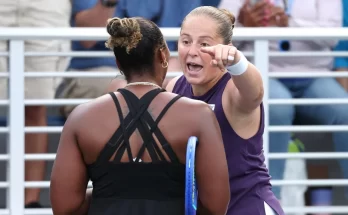Trent Frederic will now wear jersey number 10, taking over the number last worn by Derek Ryan. Meanwhile, Andrew Mangiapane is making the switch to number 88, previously worn by Brandon Davidson.
Trent Frederic and Andrew Mangiapane are two names that have steadily gained prominence in the National Hockey League. While both have carved out meaningful roles on their respective teams, they now find themselves making subtle, yet symbolic changes ahead of the new season. Jersey numbers may seem trivial to the casual observer, but in the realm of professional sports, especially in hockey, they carry deep meaning—historical relevance, personal motivation, and a connection between the player and the fan base. In a recent development, Frederic has changed his jersey number to #10, a number previously worn by veteran center Derek Ryan. Meanwhile, Mangiapane will be skating in #88, taking over from the last player to wear it, defenseman Brandon Davidson. These seemingly small adjustments open the door to larger stories of evolution, legacy, and what each player hopes to achieve in the next chapter of their careers.
Trent Frederic’s move to #10 is more than just a numerical change on the back of his jersey—it’s an indication of growing confidence and responsibility. Drafted 29th overall by the Boston Bruins in the 2016 NHL Draft, Frederic has steadily worked his way up the organizational ladder, transitioning from the AHL’s Providence Bruins to carving out a valuable role in Boston’s bottom six. Known for his physicality, grit, and willingness to drop the gloves, Frederic initially made headlines as a tough, old-school forward. However, over time, his game has matured. The switch to #10 could symbolize a fresh chapter as he shifts toward becoming a more well-rounded contributor. Derek Ryan, who last wore #10, was recognized as a steady and versatile forward—traits Frederic himself is beginning to embody more with each passing season.
The number ten has a storied tradition in hockey, often associated with finesse, creativity, and leadership. It’s a number worn by legends like Guy Lafleur, Pavel Bure, and Ron Francis. For Frederic, wearing #10 could be a step toward redefining how fans and teammates see him—not just as a grinder or enforcer but as someone with the potential to lead, score, and drive possession. He has already begun to show flashes of offensive upside, notching career-high totals last season in goals and points. The Bruins organization seems to be rewarding that growth with increased ice time and more opportunities to contribute in key situations.
In Boston’s lineup, Frederic is no longer just the agitator thrown out to spark emotion. With Patrice Bergeron and David Krejci retired and Brad Marchand getting older, the Bruins are subtly entering a transitional phase. Younger players are being asked to shoulder more of the burden, both offensively and in leadership roles. By choosing a number like #10, Frederic may be silently signaling his readiness to accept that challenge. It also deepens the connection with Bruins fans, who are always eager to rally behind a hardworking, blue-collar player evolving into something more.
Over in Calgary, Andrew Mangiapane is also undergoing a change. He’ll now don #88, a number last worn by Brandon Davidson. Mangiapane’s journey has been one defined by resilience and unexpected rises. Drafted in the sixth round (166th overall) in 2015, the undersized winger has consistently defied the odds, becoming one of the Calgary Flames’ most dynamic and productive players. He’s fast, tenacious on the forecheck, and has a knack for finding the back of the net in clutch moments. His breakout 2021–22 campaign saw him tally 35 goals and firmly establish himself as a key piece of Calgary’s core.
Switching to #88 feels like an intentional move, especially given the number’s associations across the NHL. Most notably worn by stars like Patrick Kane and David Pastrňák, #88 is often tied to flair, elite skill, and offensive firepower. For Mangiapane, who plays with a combination of speed, skill, and hustle, the number seems to fit his evolving identity. He’s no longer the late-round pick trying to prove he belongs. He’s a top-six forward, a dependable goal scorer, and potentially one of the leaders on a team that has gone through its fair share of turbulence in recent years.
Brandon Davidson, the last Flame to wear #88, was a depth defenseman known more for his physical play than offensive production. That contrast could not be more symbolic. As Mangiapane takes over #88, he’s effectively flipping the narrative of the jersey’s legacy within the organization. No longer will it be associated with bottom-pair minutes or defensive-zone starts. Now, it will likely be seen flying up the wing, finishing a one-timer or crashing the crease for a rebound goal. This is a testament to how jersey numbers, while static in form, can take on new meanings with new ownership.
This numerical shift also comes at a pivotal moment in Mangiapane’s career. The Flames, after a disappointing season that saw them miss the playoffs, are in need of stability and resurgence. New coaching and front office changes have reenergized the fanbase, but what happens on the ice will determine whether this optimism is warranted. Mangiapane, entering the prime of his career, has the opportunity to be one of the catalysts for that resurgence. If he can rediscover his 30-plus goal form and lead by example, especially with younger players like Connor Zary and Jakob Pelletier coming up, he could set the tone for Calgary’s new era.
Both Frederic and Mangiapane are examples of how players evolve in the NHL—not just in terms of production but also in how they perceive themselves and wish to be perceived. Jersey numbers may not influence performance directly, but they are emblematic. They signal intent, aspiration, and in many cases, a fresh start. For Frederic, it may be about shedding the “tough guy only” label and embracing a more multidimensional role. For Mangiapane, it could represent a shift into the spotlight, an embrace of being one of the go-to guys on a team that needs direction.
Fans often look at jersey changes with curiosity, sometimes with skepticism. But history shows that some of the greatest transformations in hockey began with a new number and a new outlook. When Auston Matthews switched from #34 to #16 in his junior days, it wasn’t just about the digits—it was a mindset. When Joe Thornton moved from #19 in Boston to San Jose, it marked a fresh chapter in a Hall of Fame career. In similar spirit, Frederic and Mangiapane are stepping into new numerical identities with clear ambitions.
It’s also worth noting the market implications. Players who change numbers often see a spike in jersey sales, especially when the change coincides with an uptick in performance or increased visibility. For Frederic and Mangiapane, two players beloved by their respective fan bases, this could lead to a surge in popularity—more kids wearing #10 in Boston and #88 in Calgary, more visibility during national broadcasts, and possibly even marketing opportunities. Numbers sell, and when they’re backed by performance, they become part of the lore.
As the 2025–26 NHL season draws closer, both players will have a chance to show that their new numbers are more than a cosmetic update. Frederic’s #10 could become a staple in Boston if he continues his upward trajectory and becomes a mainstay in the team’s top nine. Mangiapane’s #88 has all the potential to become iconic in Calgary, especially if he reasserts himself as a 30-goal scorer and playoff difference-maker. The game is played on the ice, but in the culture of hockey, symbolism matters.
The NHL is a league rich with tradition but always evolving. New stars rise, old numbers get new meaning, and players constantly reinvent themselves to stay ahead. Trent Frederic and Andrew Mangiapane may not be the flashiest names in the league, but both are poised for impactful seasons. And whether consciously or not, their jersey number changes signal readiness for the next level. Fans will be watching closely—not just for the plays they make, but for what the numbers on their backs come to represent in a sport that thrives on heritage, identity, and reinvention.



